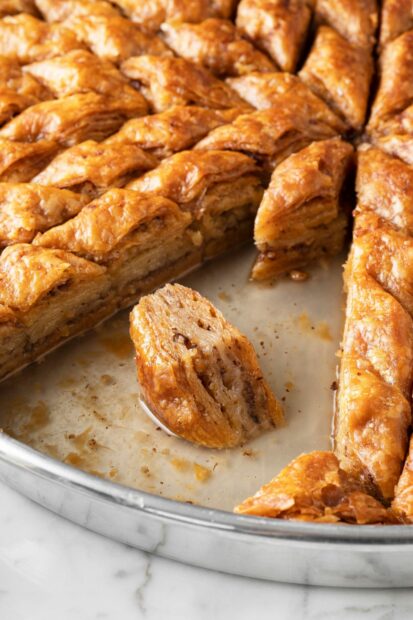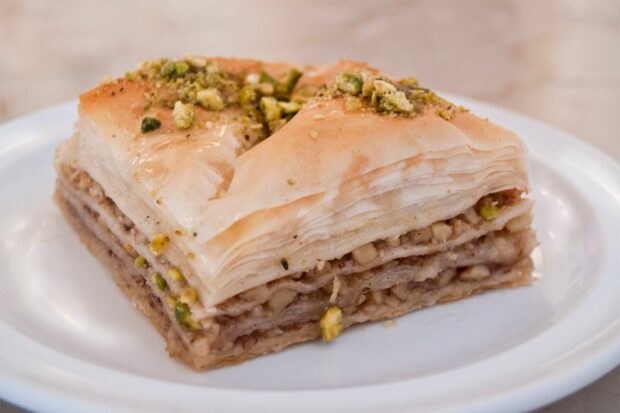Baklava is a sweet, light dessert made with phyllo leaves and nuts, not to mention butter and filling.
The main difference between Turkish and Greek versions of baklava is in the ingredients themselves, particularly the type of nuts, butter, and syrup used.
What Is Baklava?

Turkey usually claims paternity of the dish known as baklava, but Greece, Cyprus, and other Middle Eastern countries claim the same. Regardless of where the dish started, learning the differences between these two types of baklava starts with learning what baklava is.
Baklava is made with phyllo sheets, honey or syrup, butter, nuts, and other sweet ingredients. It is light but delicious and something many people find they can’t stop eating!
Starting any type of baklava begins with sheets of phyllo dough that are separated and placed in a pan, with melted butter and vegetable oil slathered on each of the sheets. Nuts are next, and they are usually placed in between each of the sheets as well. And while most baklava consists of layers of phyllo sheets in between the nuts, some people cook it with nuts in the middle and only a phyllo sheet on the top and bottom of the dish.
At this point, baklava is cut into shapes, usually squares, although some restaurants cut them into diamonds or triangles. It is usually baked at this point for about 30 minutes, then saturated with something such as rose water, honey, or orange flower water before being served. The baklava is allowed to cool off and is served at room temperature after nuts have been poured over it.
If you’re curious about the differences between Turkish baklava and baklava that comes from Greece, keep reading.
The Fat
While considered a favorite national dessert in many Middle Eastern countries, baklava does vary a bit depending on who is making it. For example, Turkish baklava uses butter and nothing else. Greek-oriented baklava usually uses galaktos—butter that comes from a combination of sheep and goat’s milk. Some companies use fats such as sunflower oil, but butter gives the dish a much richer flavor.

The Softness and Texture
The Turkish dish is said to always have 40 sheets of phyllo, and the top sheet must be crisp while the bottom sheet is soft without being soggy. Sometimes this is difficult to achieve. The Greek dish doesn’t always follow these rules to the letter.
Baklava is usually considered a dish for special occasions only and is often served at weddings and holidays such as Easter and Christmas.
The Filling
The delicate filling for baklava varies when it comes to the type of nuts used to make the dish. You’ll usually find pistachios in Turkish baklava and occasionally walnuts, while people making Greek baklava use walnuts more often than the other types of nuts.
The Syrup
The syrup provides a lot of sweetness to your baklava, but it is slightly different depending on what variety of baklava you’re making. For the Turkish dish, a mixture of water, sugar, and some type of lemon-based syrup is usually used. The Greek variety uses syrup with some cloves and cinnamon and sometimes a touch of honey as well.
Finally, baklava that is Turkish in nature is almost always lighter than its Greek counterpart. There could be many reasons for this, but each of the ingredients in Turkish baklava tends to be lighter than most of the ingredients found in Greek baklava. This isn’t always the case, of course, but it is a general rule of thumb.
A Satisfying Dessert
There are numerous kinds of baklava desserts since each country has its own spin on the recipe. If you like buttery and syrupy desserts with a few nuts thrown in and desserts that are filling but won’t make you feel stuffed after eating them, baklava is a great option for you. You can alter the recipe a little to suit your personal taste, but regardless of its type or where it came from, this is one delicious dessert you won’t regret eating.
